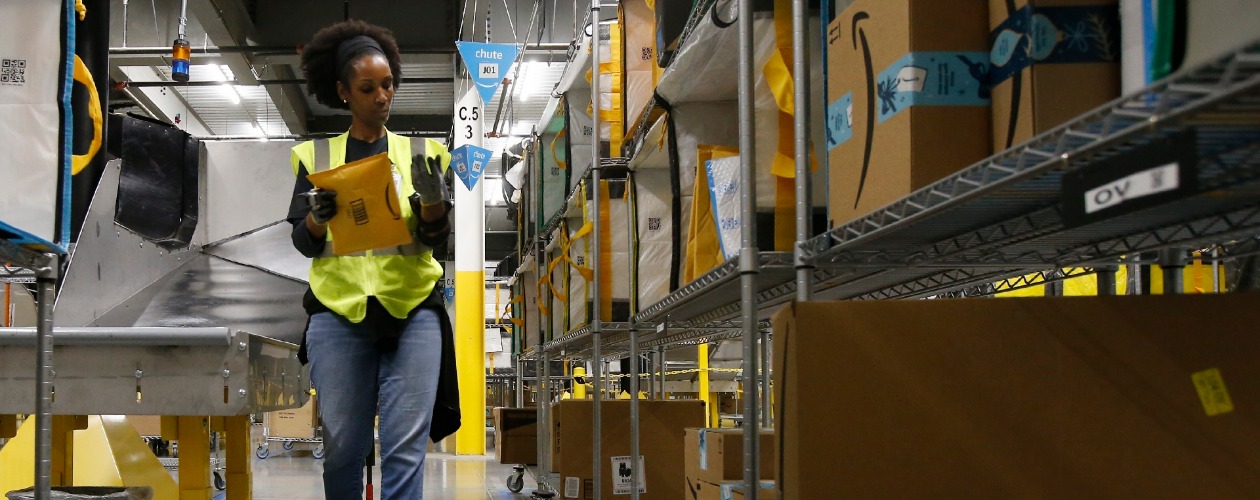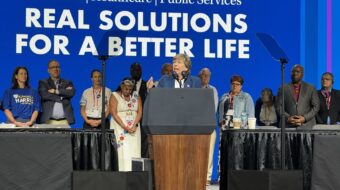
CHICAGO—Amazon’s labor law-breaking against its workers in cases involving a warehouse in Staten Island, N.Y., and two Chicago-area ones, in Cicero and Gage Park, forced the exploitative monster firm to settle a National Labor Relations Board case against it.
The settlement starts by naming only the specific complaints, reaching back to March, and NLRB rulings in those cases. But the text of the NLRB’s notice makes it clear Amazon workers can bring complaints about violations when they occur elsewhere.
The settlement was reached after joint filings with the NLRB by organizers with Amazon Labor Union in Staten Island and Amazonians United Chicagoland.
Enforcement of the agreement will be national. Amazon must prominently post the settlement notice in every warehouse and every other facility it owns, in multiple languages, and it must e-mail or mail it to every worker it’s employed since March, even if the worker no longer toils at Amazon.
Further, NLRB General Counsel Jennifer Abruzzo, in an e-mailed statement to an analytical website, The Verge, made it clear the board would keep a sharp eye on Amazon for further law-breaking from coast to coast.
The settlement’s key count overturns Amazon’s bans on “access to nonworking exterior areas of our facilities in the United States, such as our policy that restricts your access to non-working areas beyond 15 minutes of the start and end of your shifts.”
Amazon also promised, “not to retaliate against workers exercising their rights by telling them they’re violating the access policy, or any other off-duty policy, by asking you to leave the premises because you were in…non-work areas such as the breakroom or onsite medical unit during non-work time, while we allow other off-duty employees who are not participating in union or protected concerted activities to access those same areas.”
And Amazon promised not to call the cops on workers who seek to talk to their colleagues in non-work areas, the notice says.
Though there were no NLRB fines for Amazon’s labor law-breaking, the settlement could crimp the firm’s union-busting, which it successfully pulled at its Bessemer, Ala., warehouse in early 2021. And the settlement still doesn’t change basic working conditions at the monster retailer and distributor, owned by Jeff Bezos, one of the three richest people in the U.S.
Those conditions, such as overcrowding, crazy hours, massive speed-ups, penalties and firing for not keeping up, and failure to protect workers against the coronavirus, forced a worker walkout at Amazon’s Cicero and Gage Park warehouses two days before Christmas, the workers’ group, Amazonians United Chicagoland, reported in social media postings.
“We have been passed over for raises. We are being overworked, even when there are sufficient people to work here,” a worker at the DLN2 warehouse in Cicero said in a live stream on the Amazonians United Chicagoland website. “We have not received the bonuses we were promised. There are people here who were hired as permanent workers, and then they took their badges away and made them temporary workers. They are staffing this place unsafely, making people work too fast, even though we don’t have to.”
With case counts rising in the Staten Island fulfillment center, Amazon Labor Union warned on Christmas Eve, “It’s going to be another dark time for workers and our communities.” As cases exploded, the workers said “the company continues to obfuscate the number of cases and who has been exposed.” They concluded, “It’s time for collective action.”
The conditions in Chicago and Staten Island mimic those which millions of exploited low-paid over-worked employees, many of them classified “essential” but unprotected from the coronavirus pandemic, face at the hands of anti-worker corporate moguls and their Wall Street backers.
Those fed-up workers, having had it, have either been forced to strike, walked out on their own, or just plain quit their exploitative jobs in favor of better employment, all in numbers unseen in decades.
In the Chicago Amazon warehouses, “It’s been six months of this inhumane ‘megacycle’ shift of 1:20 a.m. to 11:50 a.m., constant speedup and disrespect from management,” their key posting begins. “And management continually cuts staffing to key warehouse roles that results in more back-breaking knee-crushing movement,” another worker’s post says.
“We have so many stories of our lives being disrupted” by that shift, the long post adds. “so many mothers struggling to care for their families, so many of us waking up feeling like zombies every day” after short naps, but having to go to work to provide for their families.
“Today we got fed up and walked out,” on December 23, “demanding schedule accommodations for people who need it, Lyft rides to and from work” due to lack of nighttime mass transit to and from Gage Park and Cicero, and $2 per hour shift differentials, rather than the 50-cents difference Amazon pays. They’re also demanding a $5 hourly raise.
“We are proud most workers walked out” and only 10 stayed, their text said. At their rally “we busted out laughing cuz we put ALL the managers to work,” ending the sentence with a laughing yellow emoji.
“A few hours later at DL3, 30 of us gathered in the break room and walked out, to be met with coworkers from DLN2, TV cameras, and the Chicago winter wind,” another tweet read. “There were about 15 co-workers who remained in the facility and six extra managers that Amazon had called in from other sites.”

Saying bosses always spy on the workers, the workers texted Amazon had to scramble for outside managers—not workers—to come in and actually toil at the warehouse jobs. That development produced more worker glee.
“Maybe they wanted to scare us, but we know WE MADE THEM ALL SWEAT TODAY. It’s probably the first time they’ve ever worked,” the workers texted.
The Amazon workers who were forced to strike also texted that bosses hoped that by bringing in the outside managers “they’d get rid of the union.”
Instead, Amazon shut the warehouse involved—the workers didn’t specify if it was in Cicero, Gage Park, or elsewhere–and Amazon management intruders “pissed us off even more.” The union movement has spread, workers wrote, to warehouses all over Chicago.
And the Chicago walkout wasn’t the only worker action against Amazon in late December. After the massive tornado that roared through Illinois, Kentucky, and other states smashed an Amazon warehouse in Edwardsville, Ill., killing six workers, Amazonians United revealed bosses there and elsewhere ban workers from carrying personal cell phones inside.
Had the Edwardsville workers had their cell phones, they would have received tornado alerts and been able to escape. So 380 workers at six warehouses signed and presented an Amazonian Workers United petition demanding the firm let them carry personal cellphones inside—along with other pro-worker demands, such as raises for that megacycle shift.
The workers at those warehouses—two in the Bronx, two in Queens, one in South Jersey, and one in Baltimore—reported: “the no-phones policy is off until further notice.”












Comments